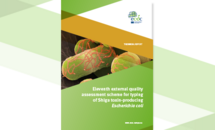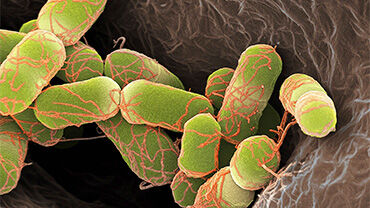Eleventh external quality assessment scheme for typing of Shiga toxin-producing Escherichia coli
This report presents the results of the 11th round of the external quality assessment (EQA-11) scheme for typing of Shiga toxin-producing Escherichia coli (STEC). This EQA was organised for national public health reference laboratories (NPHRLs) providing data to the Food- and Waterborne Diseases and Zoonoses Network (FWD-Net) managed by the European Centre for Disease Prevention and Control (ECDC). Since 2012, the unit of Foodborne Infections at Statens Serum Institut (SSI) in Denmark has arranged the EQA under a framework contract with ECDC. EQA-11 contains serotyping, detection of virulence genes, and molecular typing-based cluster analysis.
Executive Summary
Human STEC infection is a zoonotic disease. For 2021, 6 534 confirmed cases of STEC infection were reported by 30 EU/EEA countries. Twenty-seven countries reported at least two confirmed cases, and three countries reported no cases. The EU/EEA notification rate was 2.2 cases per 100 000 population, representing a 37.5% increase compared with the previous year. The five most frequently reported serogroups were O157 (15.1%), O26 (14.7%), O103 (8.4%), O145 (4.6%), and O146 (3.7%).
Since 2007, ECDC has been responsible for the EU-wide surveillance of STEC, including facilitating the detection and investigation of food-borne outbreaks. Surveillance data, including basic typing parameters and molecular typing data for the isolated pathogen, are reported by Member States to The European Surveillance System (TESSy). The surveillance system relies on the capacity of NPHRLs in FWD-Net providing data to produce comparable typing results. To ensure that the EQA is linked to the development of surveillance methods used by
NPHRLs, a molecular typing-based cluster analysis using either pulsed-field gel electrophoresis (PFGE) and/or whole genome sequencing (WGS)-derived data has been included since EQA-8.
The objectives of the EQA are to assess the quality and comparability of typing data reported by NPHRLs participating in FWD-Net. Test strains for the EQA were selected to cover strains currently relevant to public health in Europe and represent a broad range of clinically relevant types of STEC. Twelve test strains were selected for serotyping/virulence profile determination and molecular typing-based cluster analyses. Eight additional strains (sequences) were included for the molecular typing-based cluster analysis. Twenty-seven laboratories registered and 26 completed the exercise, comparable to EQA-10.
The full O:H serotyping was performed by 73% (19/26) of participating laboratories, with an average score of 95%. In general, the more common European serotypes generated the highest scores compared to the less common serotypes, such as O187:H28, O80:H2, and O91:H14, which proved more difficult to identify, particularly if participants used phenotypic methods. Notably, not all laboratories demonstrated the capacity to determine all O groups and H types and the participation in H typing was low (19/26), although higher than EQA-10 (16/19), most likely reflecting a shift towards WGS-based methods. This could also be seen in the reported O-grouping results, where 60% (15/22) used WGS-based methods, which is higher than EQA-10 (52%), EQA-9 (50%), and EQA-8 (26%).
The quality of the virulence profile determination results was generally good, with high average scores of 97%, 99%, and 96% for eae, stx1 , and stx2 , respectively, similar to previous EQAs.
In EQA-11, two other diarrhoeagenic E. coli (DEC) pathotypes were included – EAEC Strain 12 (aggR gene) and ETEC Strain 2 (esta gene) – testing the participating laboratories in their abilities to detect STEC hybrid strains (Strain12 and Strain2). The performance of detection of the aggR genes was high (21/22, 95%) which is comparable to EQA-10, where 94% correctly identified aggR. Likewise, the performance for esta was also high (89%), where only two laboratories reported a false negative result. Both laboratories used other methods than WGS.
Of the 26 laboratories participating in EQA-11, 20 (77%) performed molecular typing-based cluster analysis using WGS data analysed by different approaches. Notably, all laboratories used WGS in EQA-11 and none chose PFGE, a decrease from EQA-10 (two laboratories) and EQA-9 (eight laboratories). The purpose of the cluster analysis part of the EQA was to assess the NPHRL’s ability to identify a cluster of genetically closely related strains, i.e. to correctly categorise the cluster test strains regardless of the method used. The focus is on the result, not a specific procedure.
Sixteen participants (80%) correctly identified the cluster of five closely related ST11 strains defined by precategorisation from the EQA provider among the 12 test strains and eight test strains (genomic sequences).
Also in this EQA, participants were free to choose their preferred analytical method for the WGS-based cluster identification. An allele-based method was most frequently used; 80% (16/20) used core genome MultiLlocus Sequence Type (cgMLST) compared to 20% (4/20) using single nucleotide polymorphism (SNP) for the reported cluster analysis as the main analysis.
In general, for cgMLST the reported results from the participants were at a comparable level despite using various analysis and different allelic calling methods.
For inter-laboratory comparability and communication about cluster definitions, cgMLST using a standard scheme (e.g. Enterobase) gives a very high degree of homogeneity in the results, while the use of non-standardised SNP analysis may be more challenging. There are two main challenges: difficulty in comparing SNP with cgMLST results, and variations between SNP analyses in general, as demonstrated in this EQA, which makes the comparison and communication between laboratories difficult. The latter was reflected in the reported results, as
three of the laboratories that used SNP-based analysis did not identify the pre-determined cluster.
The participants assessed additional genomes, some of which were modified by the EQA provider in order to give a realistic view of different quality issues. Most of the participants (17/20) successfully identified the 14% contamination with E. albertii , and the poor quality for one genome was observed by all 20 laboratories. Both contamination with a different species and poor quality are important to assess before the analysis of WGS.
A feedback survey was sent to assess the STEC EQA scheme. The questionnaire contained both questions related to accreditation and information on the individual report; 15/26 responded. The usefulness of the QC evaluation of the participant-sequenced data and the usefulness of including low quality data were appreciated by 86–93% of respondents.







